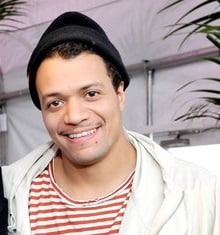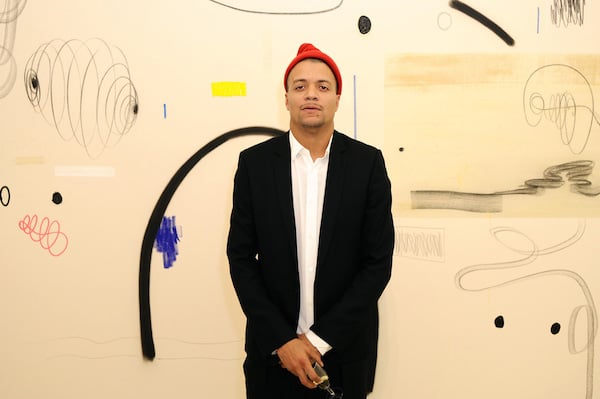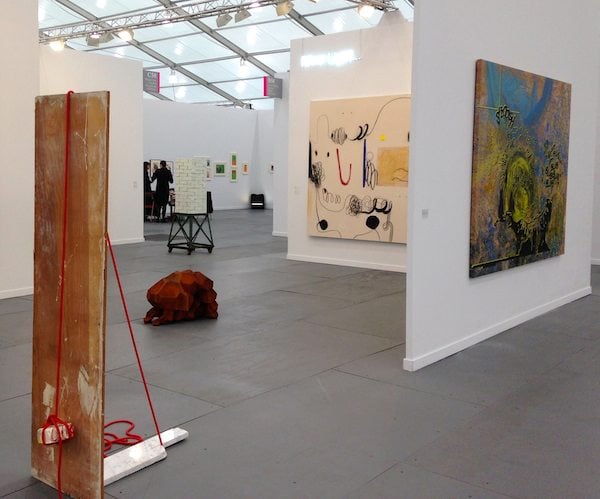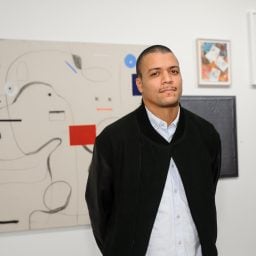


Christian Rosa.
Photo: Maxime Ballesteros, courtesy Gallery Weekend Berlin.
Christian Rosa just opened a big solo at CFA during Berlin Gallery Weekend of a highly-anticipated show of new paintings, and New Yorkers can see his work in White Cube‘s booth at Frieze New York. These two exhibitions are the first major showings by Rosa, who has evolved by leaps and bounds in the past year, in terms of his paintings and his growing market success. I sought to understand Rosa’s twofold transformation—the solo exhibitions lining up and the paintings maturing—as he opens these major showcases of his work, the first of many with major galleries around the world over the next year.
Having watched the paintings evolve over the last few years, whether during the occasional studio visit or in group shows like the Brucennial, I think the riddle of the evolution in his work involves Rosa restricting his materials and getting rid of brushwork. Shuffling off a densely painted background and reducing the palette and materials drastically, he is able to lighten the load and create something that feels very fresh. The new works involve oil, charcoal, pencil, resin, and oil stick, but the forms created with these tools show no brushwork and remain autonomous in their discrete areas of the canvas: a green smudge; a blue line; a penciled circle; a flat yellow square traversed by a white squiggly line. The charcoal is used often as a point but also sideways as a calligraphic marker of width. The main line work is curled up tight like a telephone cord or a Victorian wig, with straight lines all terminating in cuneiform whirligigs. It evokes the whimsy of drawing a curly mustache on a subway poster, but with hints of Calder’s mobiles and Mondrian’s Broadway Boogie Woogie.
As for effect, the works look provisional, fleeting, improvisational—none of these are bad things. They have the superficial appearance of a Joan Miró or automatic drawing, and perhaps they were made in a similar way. The paintings related to the lineage of Julian Schnabel into Joe Bradley, with the offshoot of Oscar Murillo muddiness. But with Rosa, it’s as though all the areas of smeared or trodden-on paint have receded back into their discrete areas of the canvas. They are linked together not through commingling, but instead as a kind of Rube Goldberg machine, where the blue ball falls down the hole, rolls around the grey track, knocks over the yellow rectangle, which falls into the brown cup. And like a Rube Goldberg device, we have a complicated visual set of interrelated and sequential occurrences that lead to something in the end very simple, which is here perhaps a light bulb of visual pleasure turning on.

White Cube‘s booth at Frieze New York, with a Christian Rosa painting at center.
Courtesy White Cube.
I don’t think metaphysics or a millennial recapitulation of the avant-garde is part of the artistic intent; Rosa has a very punk, free, anything-goes-in-the-pursuit-of-truth-beauty-love sort of rebelliousness that doesn’t mesh with an over-intellectualized reading of the works. I would suggest instead that the proper approach factors his lifestyle and personality into the pieces; a guy who isn’t concerned with luxury and instead shares a huge studio with a bunch of chums he plays with and stays up until morning with and doggedly makes paintings with as well. I spoke with Rosa in the new 15,000-square-foot work and project space in Downtown Los Angeles that he shares with his buddies.
When and how did you begin painting and decide that was your metier?
I never choose painting, it choose me. I started in 2006.
What was the painting school like in Vienna? What are some of the key things you learned there?
Art school was fun and I learned the most from my fellow students, friends, and artists in the class. Mostly Alexander Ruthner, Michi Lukas, Rade Petrasevic, and Daniel Richter fucking us up at painting reviews.
Where did you grow up and how did you spend your childhood?
I was born in Brazil grew up in Vienna because Brazil was so dangerous. So we moved to Vienna, where my step-dad is from.
Can you tell me some about your family?
I grew up with three siblings and it was mad fun—two sisters and an older brother. Me and my brother used to go skate every day; it was so much fun. Chaos household, big family style, maybe something like “Roseanne.”
What are some of the aspects of painting that you love?
The dark side: failing, getting back on your feet, and confronting problems in the best way so people be like: WTF, this shit looks awesome.
Have you worked in other media before?
Yes, I did a lot of photography and film before painting. I am planning a feature film with Eugene Kotlyarenko. I love this dude so much; he is the best filmmaker I know out there.
Your recent works are often on raw canvas; what changed with you that led to this new approach and what are you trying to accomplish with these new works?
I’m trying to evolve my own language step by step and just to make them basically look good for me, so I am happy.
Who are some painters you like who have influenced you or that you look at on a regular basis?
Daniel Richter, Cy Twombly, Cyprien Gaillard (not a painter, but a big influence), Albert Oehlen, Dieter Roth, and a lot of people like Alexander Ruthner, Michi Lukas. Basically my friends.
What are some upcoming exhibitions you have planned, and what are you going to do for them?
I am doing this show at CFA and then at the Gagosian space in Athens in September. Then something at some other huge galleries, but it’s still all very secret.
Tell me about how you decided to settle in LA and what you like about it.
I love the good weather; Vienna is always very grey in winter time. I love to surf and skate and the cheap rent—New York is dead. I nearly moved to Athens. I love it and I am sure I’m gonna move back there, just waiting for Andreas Melas to fix me up over there. He gave me a residency last summer where I painted for three months. Hopefully i get it this summer again.
Tell me about your studio space, your friends, your scene in Downtown LA.
I have a 15,000-square-foot space where I have my studio in the back and my outdoor area. We have set up a residency that’s a three-month stay. I invite artists to stay and I got a gallery on the front where I showcase their works at the end of every residency. Besides that I want to invite curators to do shows in here; The first show will be on may 30, with Alexander Ruthner, Martin Grandits, and Björn Segschneider. Come by, it’s gonna be fun!
Tell me about your process.
I work on many different canvases at once, I like friends around me painting, and then also sometimes I don’t like when there are people around me.
Do you like meeting and discussing art with other artists, collectors, and critics? Do you spend a lot of time discussing painting?
I like to meet people in general and talk about art, especially with my friends Raymond Pettibon and the art historian Roberto Ohrt, who is doing the text for my catalog coming out this summer in Switzerland for Art Basel. I discuss painting with my friends all the time.
Follow Artnet News on Facebook:
Want to stay ahead of the art world? Subscribe to our newsletter to get the breaking news, eye-opening interviews, and incisive critical takes that drive the conversation forward.






